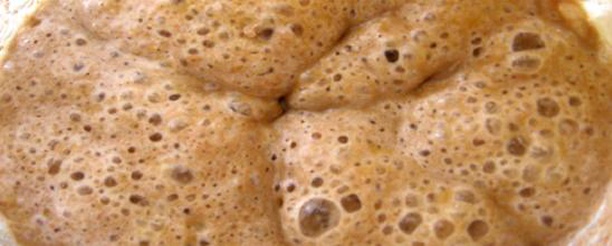















Learn About Sourdough
Media
Order Sourdough
Sourdough Starter Troubleshooting
Not Activating (or weak activation):
• Continue feeding. Sometimes it will just take longer for one reason or another, but it will
eventually activate.
• Check that your water is not heavily chlorinated or otherwise chemically altered. If you have well water, you may want to check for unsafe levels of nitrates, arsenic, etc. *Distilled water lacks needed minerals - switch to purified, spring, clean tap or mineral water if this is the case.
• Also, sourdough prefers whole grains to feed on. Try adding some rye flour, or some whole grain flour (partial or all).
• Check that the temperature is not above 78°F, or it will be too hot for a balanced fermenation to take place.
• Make sure the lid is not on tight- sourdough loves oxygen.
• Make sure nothing else is going in it, and you aren't placing the starter near something hot or in a room with toxic fumes (new paint, carpet, etc) as this can weaken the starter as well.
• If it does not activate in 2 weeks, restart with a new batch of starter (this rarely happens).
• Check that your water is not heavily chlorinated or otherwise chemically altered. If you have well water, you may want to check for unsafe levels of nitrates, arsenic, etc. *Distilled water lacks needed minerals - switch to purified, spring, clean tap or mineral water if this is the case.
• Also, sourdough prefers whole grains to feed on. Try adding some rye flour, or some whole grain flour (partial or all).
• Check that the temperature is not above 78°F, or it will be too hot for a balanced fermenation to take place.
• Make sure the lid is not on tight- sourdough loves oxygen.
• Make sure nothing else is going in it, and you aren't placing the starter near something hot or in a room with toxic fumes (new paint, carpet, etc) as this can weaken the starter as well.
• If it does not activate in 2 weeks, restart with a new batch of starter (this rarely happens).
What's that Smell?
Sometimes due to activation, temperature, water or flour change (and seasonal changes), a starter can give off a funny smell. Don't be alarmed, it is just re-adjusting. If it continues, check to make sure you aren't contaminating the jar or keeping the temperature too hot in the room. Some of the smells include beer, wine, fresh paint, burnt popcorn, strong cheese, raisins, and old bananas. A rice starter should smell like a yeasty milk biscuit when balanced. A wheat, rye or spelt starter should smell like a light beer mixed with fresh bread and a slight zip or tang to it.
Mold
Usually not a problem! Scrape off, switch to a clean jar, feed it a couple times using your regular process and it should rebalance in a couple days and be good to go! If there are streaks of color, throw it out and start over.
Too Slow or Too Fast of a Fermentation
First check if the temperature is too cold (below 72°F). Otherwise this may mean there isn’t balanced, especially if the starter gets soupy and loses its stringy elastic structure. In this case, give it a nice mix of plain and whole flour and a warmer temperature and feed often (right after it doubles in size) to restore strength. If the starter has already activated completely but liquid rises to the top of the starter (and its not doubling very well), stir it back in to redistribute the food supply. This can sometimes happen with a sluggish or weak starter once in awhile. Sourdough actually likes to be stirred inbetween feedings anyways! A liquid hooch layer in the middle or top just means it has exhausted its food, and needs to be fed more, and possibly kept at a cooler room temperature.
Sometimes due to activation, temperature, water or flour change (and seasonal changes), a starter can give off a funny smell. Don't be alarmed, it is just re-adjusting. If it continues, check to make sure you aren't contaminating the jar or keeping the temperature too hot in the room. Some of the smells include beer, wine, fresh paint, burnt popcorn, strong cheese, raisins, and old bananas. A rice starter should smell like a yeasty milk biscuit when balanced. A wheat, rye or spelt starter should smell like a light beer mixed with fresh bread and a slight zip or tang to it.
Mold
Usually not a problem! Scrape off, switch to a clean jar, feed it a couple times using your regular process and it should rebalance in a couple days and be good to go! If there are streaks of color, throw it out and start over.
Too Slow or Too Fast of a Fermentation
First check if the temperature is too cold (below 72°F). Otherwise this may mean there isn’t balanced, especially if the starter gets soupy and loses its stringy elastic structure. In this case, give it a nice mix of plain and whole flour and a warmer temperature and feed often (right after it doubles in size) to restore strength. If the starter has already activated completely but liquid rises to the top of the starter (and its not doubling very well), stir it back in to redistribute the food supply. This can sometimes happen with a sluggish or weak starter once in awhile. Sourdough actually likes to be stirred inbetween feedings anyways! A liquid hooch layer in the middle or top just means it has exhausted its food, and needs to be fed more, and possibly kept at a cooler room temperature.
Copyright © 2015 Yemoos Nourishing Cultures. All rights reserved.
Shop | Forum | Blog | Contact Us




























